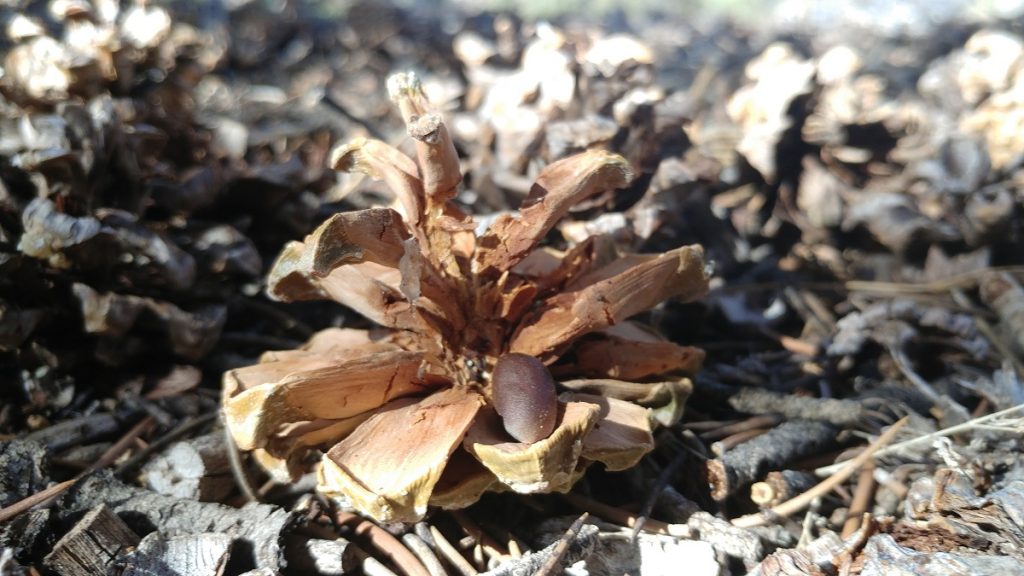
After climbing over the Sierra Nevada mountains from the west to the east, the landscape drops into the Great Basin. Here it is the country of sagebrush steppe, desert grasslands, cottonwood and aspen canyons, river willows, and piñon-juniper forests. This year, on the border of Nevada and California I gathered pinenuts from the single-needle piñon trees (Pinus monophylla). It wasn’t my first time gathering pinenuts — I gathered from the two-needle pinyon Pinus edulis in Taos, New Mexico in 2015 — but this was a really enjoyable trip and I got to dig deeper into the ecology of these trees as well as the ins and outs of the pinenutting process.
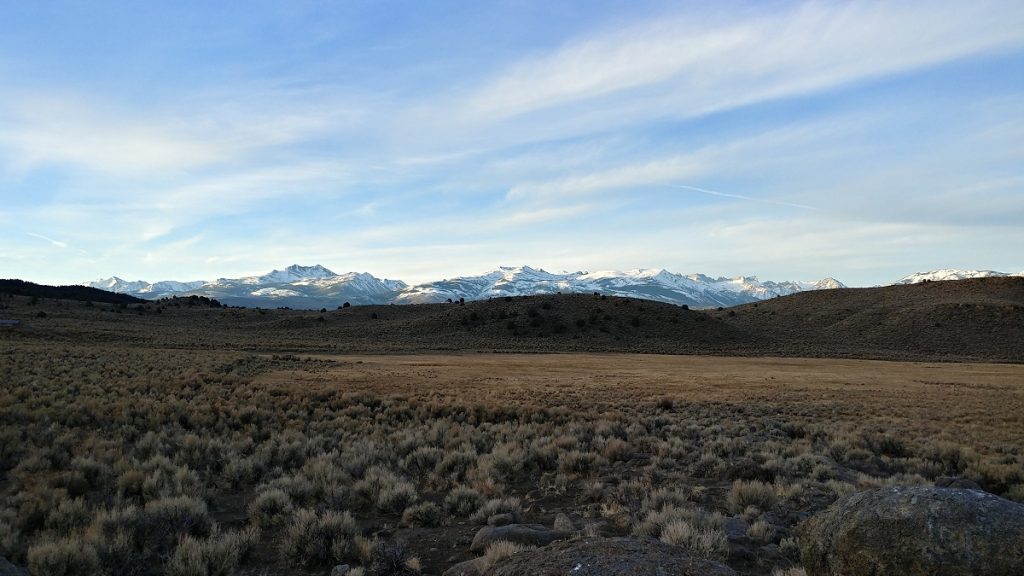
Coming out of the Sierras, the dominant tree cover is ponderosa pine (Pinus ponderosa). As you get into the basin, the ponderosas get sparser and sparser as the great sea of sagebrush steppe begins to dominate the landscape. And up along the high ridges, especially the north-facing slopes, that’s where you start to see the piñon-juniper woodlands. At first the piñon-juniper is mixed with the ponderosa, but as you get further into the basin the piñon-juniper becomes more exclusive. These forests seem to really thrive at the mid-to-high elevations, between about 6,500 and 9,500 feet with the highest densities being around the 8,000-9,000 foot ballpark.
But there seems to be a lot of range in elevation tolerances depending not only on the species of piñon, but also the latitude. Piñons can be found almost to 10,000 feet elevation in the more southern regions of its range in the United States, but in the northern portions of its range it is often found at 4,500-6,000 feet elevation and mostly on south-facing slopes. It’s a harsh environment out there in the desert! And that’s one of the very things I like about the desert. The way the landscape is laid out makes very transparent the forces of geology, hydrology, and aspect, all coming together in the patterns of life.
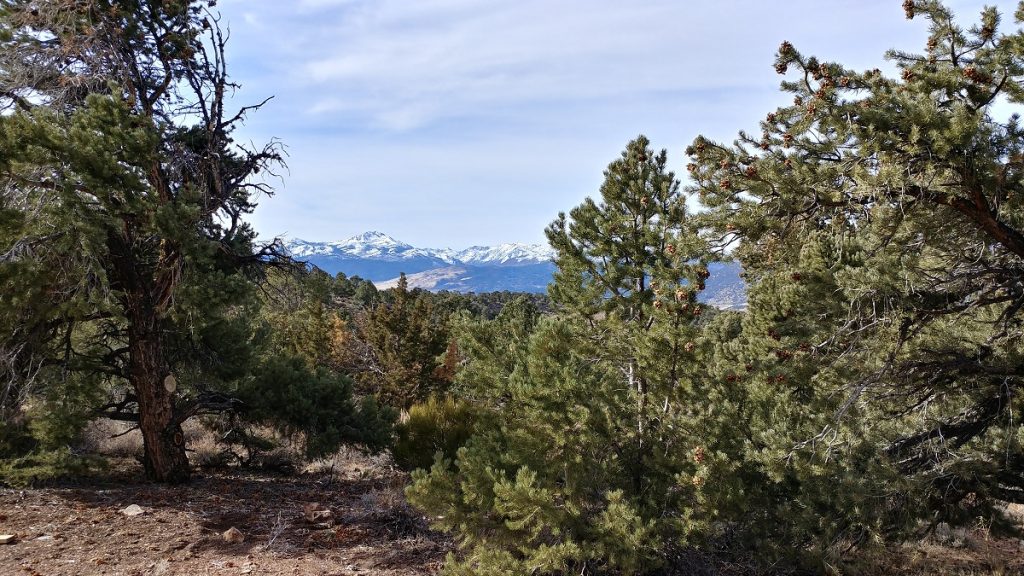
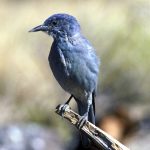
The pinyon jay calls out beside the piñons and watches me walk among them. Unlike in the eastern United States, there are no squirrels out here. The main pinenut eaters are jays, chipmunks, rats, mice, deer, and… humans! The piñon pinenut was a winter staple food for indigenous groups living in the regions where the pinyon trees grow. It was such an important food that the peoples of the Great Basin were known as “people of the pinenut” in the same way in which the people of the Great Plains were the “people of the buffalo.”
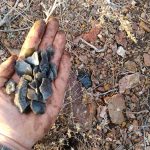
Where I am with these piñons not far away from the Walker river, I am on Paiute lands. In the Paiute language Numu, the piñons are called tubape. The Paiute people still cherish, gather, and steward their Tubape to this day, as they’ve done continuously for thousands of years. Evidence of human-pinyon coexistence is to be found scattered all over the ground among the pinyon and juniper trees in the form of obsidian flakes leftover from flint knapping. These traces are testament to hundreds of generations coming to this place every fall and winter to gather nuts, hunt jackrabbits, and pursue crafts such as leather-work and flint knapping on the side. The obsidian pictured here was brought specifically for the purposes of knapping and comes from perhaps one hundred miles away or more.
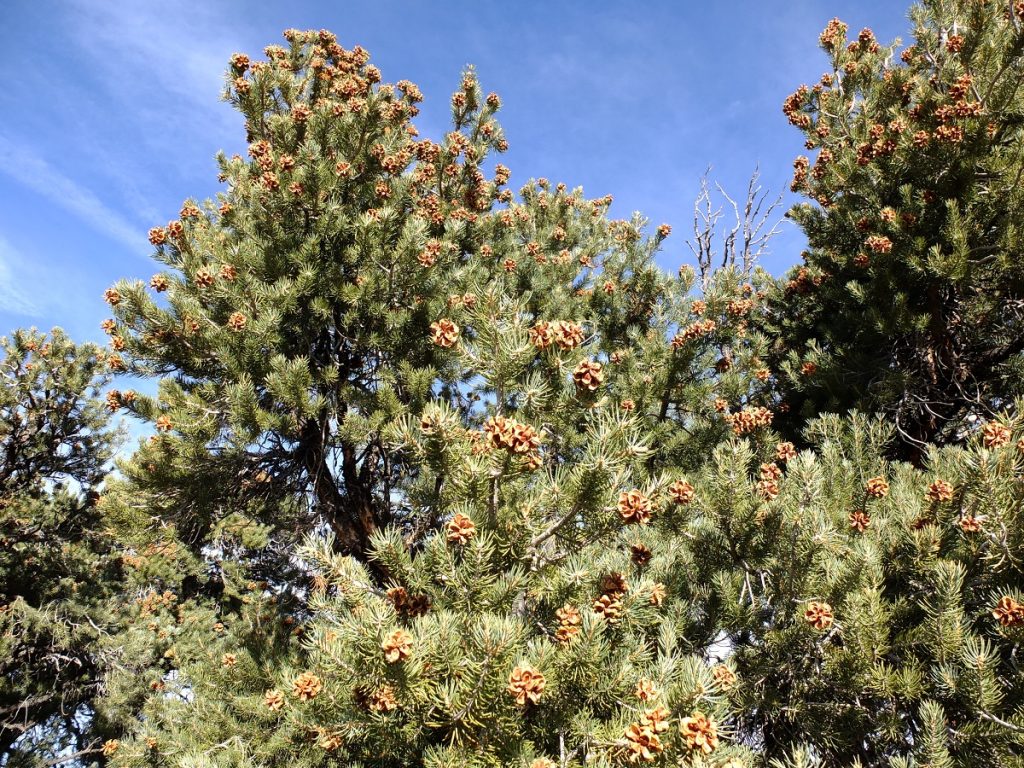
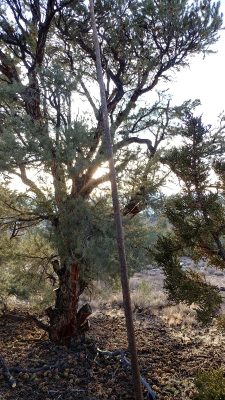
Some of the trees have crowns thick with pine cones, while others are thinner. Consider a peach tree for instance. Many orchardists will thin the fruit set on their peaches in order that the remaining fruits might grow larger. I was shown how piñon pines are no different. Those trees with dense canopies that are tight with pine cones had smaller nuts than the trees with fewer pine cones up in the canopy. Trees that had been flailed the previous year exhibited canopies that were less thick with cones, and therefore they had larger nuts. The energy of each tree may be dispersed over many cones or concentrated in a few. The act of flailing to knock cones down out of the tree inevitably breaks off some of the fruiting wood, effectively pruning the trees.
In short, this means that pinenutting is an activity with parallels to wild ricing, whereby the act of harvesting by knocking with a pole actually increases the yield in the following season. This is the essence of good stewardship as well as a beautiful example of mutualism in nature.
The pinyons are monoecious, being both male and female. They are pollinated by the wind. The pine cones open slowly in the sun, releasing the nuts inside them over a period of time ranging from early October to December. Some people begin gathering piñon cones as early as the middle of September. Although the cones are all closed at this point, the unopened cones can be slow roasted underground in an earth oven. When the oven cools 24-36 hours later and the cones are uncovered, once broken into the pinenuts inside are bright red like a lobster. I’ve never eaten pinenuts prepared this way but I hear that the flavor is unbelievable.
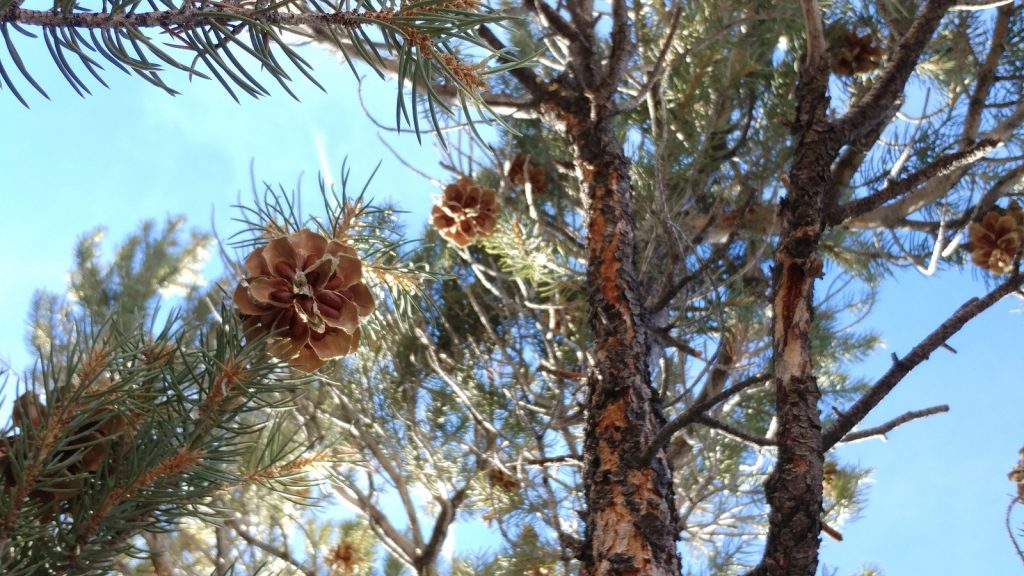
Piñon season lasts a long time, from about the middle of September to January or until the snows come. Therefore it provides for a steady abundance and a relaxed transition into the winter. After the cones have been flailed out of the tree, most of the nuts will fall out and lay upon the ground. If the cones are not fully opened and fall to the ground still closed, they can be gathered up and put inside something like a burlap sack so that as they ripen and open they release the nuts into the sack. Some people also like to put tarps under the trees to catch what falls down from flailing.
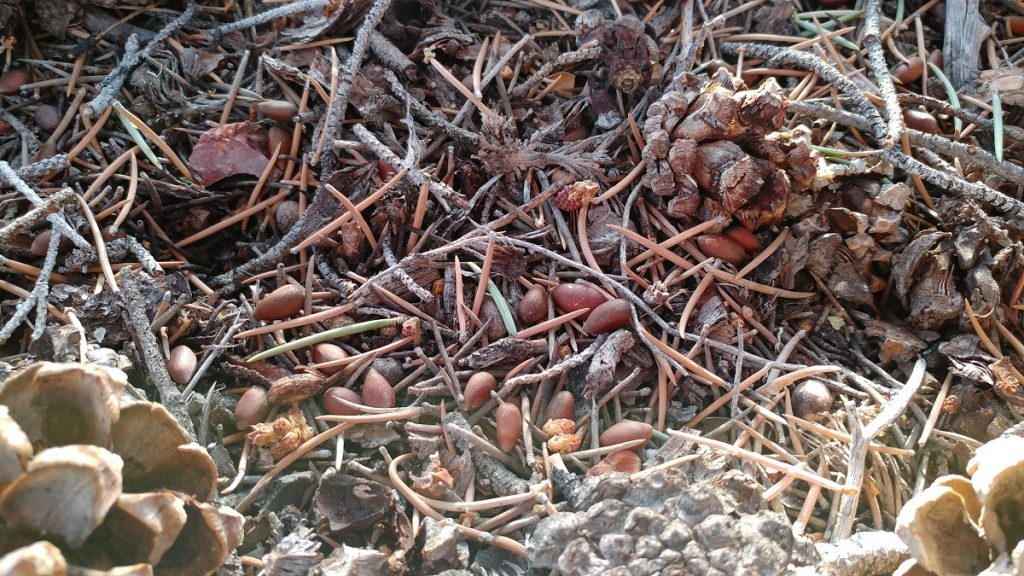
Some of the pinenuts will not fill and the shells will be empty. To avoid gathering these, I feel each one. The shells of the single-needle piñon are fairly soft, especially in contrast to the harder shells of the two-needle piñon, Pinus edulis. Because the shells are soft, you can usually tell a pinenut is filled because it feels solid in your fingers and the shell is unyielding. There are other indicators to tune into as well, such as color, and speckling. The light coloration and speckling on the nuts comes from exposure to sunlight, and because the empty shells heat up more readily, making their coloration more susceptible to sun-bleaching, appearance may be a reliable indicator for unfilled nuts. Last but not least, unfilled nuts can be discarded later through the float test. A float test is simple, you just submerge the nuts in water and watch to see which ones float and which ones sink. Fully-filled nuts settle to the bottom, but empty nuts float to the top. Unfortunately partially-filled or slightly dried nuts also float, which adds a layer of complexity. Partially filled nuts will float just below the surface tension of the water, but entirely unfilled nuts will float just above it.
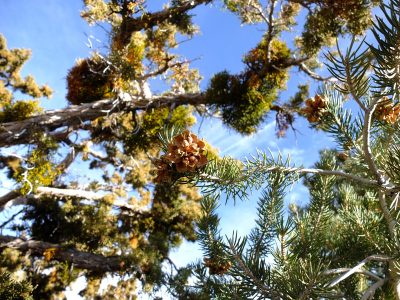
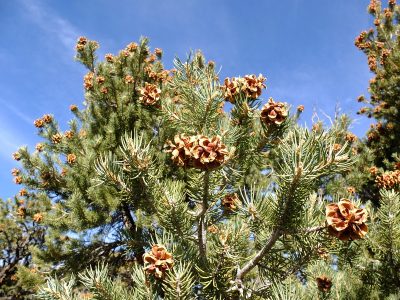 The nuts of Pinus monophylla are larger than those of Pinus edulis. Pinus monophylla, the single-needle pinyon, is mainly associated with Nevada and also has another center of distribution in Arizona. Pinus edulis, the two-needle pinyon, is associated with Colorado and New Mexico and is centered along the southern Rocky Mountains. While the single-needle and two-needle pinyon have the widest distribution within the United States, there are four additional pinyon species also present in the deep southwest along the Mexican border: Pinus cembroides (the Mexican pinenut), Pinus remota (the Texas or papershell pinyon), Pinus quadrifolia (the fourleaf pinyon), and Pinus johannis. Within Mexico are six additional pinyon pines.
The nuts of Pinus monophylla are larger than those of Pinus edulis. Pinus monophylla, the single-needle pinyon, is mainly associated with Nevada and also has another center of distribution in Arizona. Pinus edulis, the two-needle pinyon, is associated with Colorado and New Mexico and is centered along the southern Rocky Mountains. While the single-needle and two-needle pinyon have the widest distribution within the United States, there are four additional pinyon species also present in the deep southwest along the Mexican border: Pinus cembroides (the Mexican pinenut), Pinus remota (the Texas or papershell pinyon), Pinus quadrifolia (the fourleaf pinyon), and Pinus johannis. Within Mexico are six additional pinyon pines.
Nutritionally, pinyon pinenuts are superstars, containing over 60% fat (the highest of any nut) and over 30% protein. They are a rich source of linolenic fatty acids, which helps to balance hormone levels. They are also rich sources of vitamin E (alpha-tocopherol), thiamin, niacine, iron, magnesium, phosphorus, potassium, zinc, copper, and manganese.
While enjoyable to eat raw, I love the flavors they take on when roasted. Roasting the pinenuts also makes them easier to digest and their nutrition more bio-available. To roast I cover in water about one and a half times the volume (adding salt or other flavorings to the water if desired), boil the nuts in the water until all the water boils off, and then keep them continually stirred for several minutes until the nuts seem roasted. You can crack a few to see if they’ve turned brown inside, or sometimes you might know by the smell. Once roasted and left to cool down all the way (this hardens them), the shells may be cracked gently with a mortar and pestle and winnowed away from the nut meat.
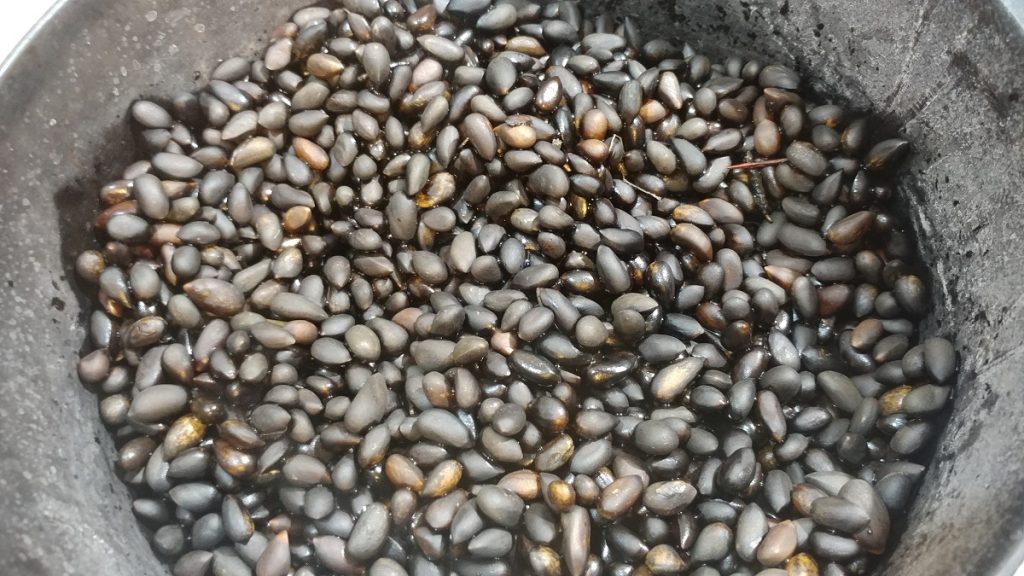
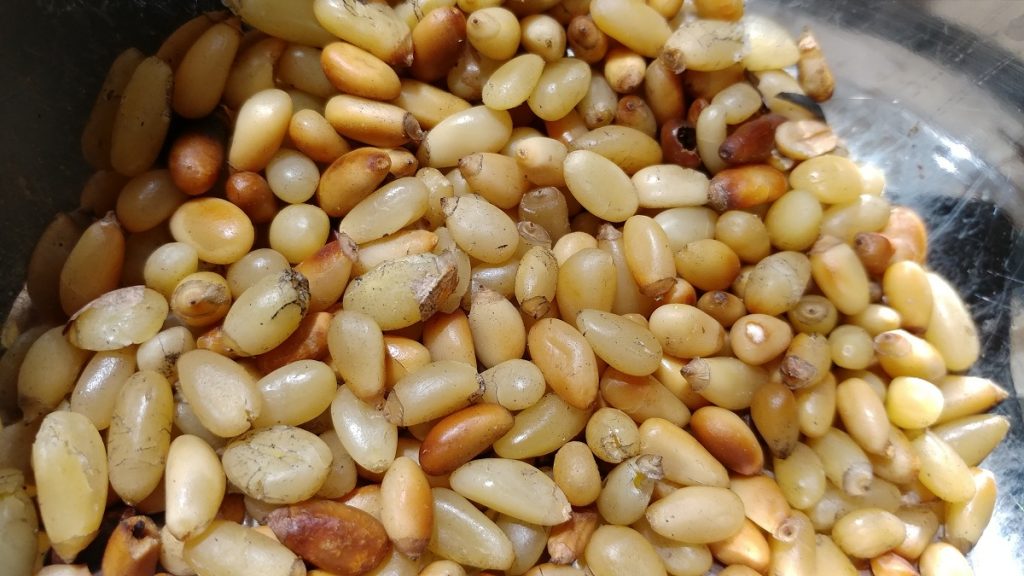
Pinenuts must remain relatively fresh for viability; they cannot dry out too much. They naturally find shelter from the sun in the duff below the pines, or underneath the snow. Which in southern California and Nevada might come for a few days and then melt, come for a few days again and then melt…
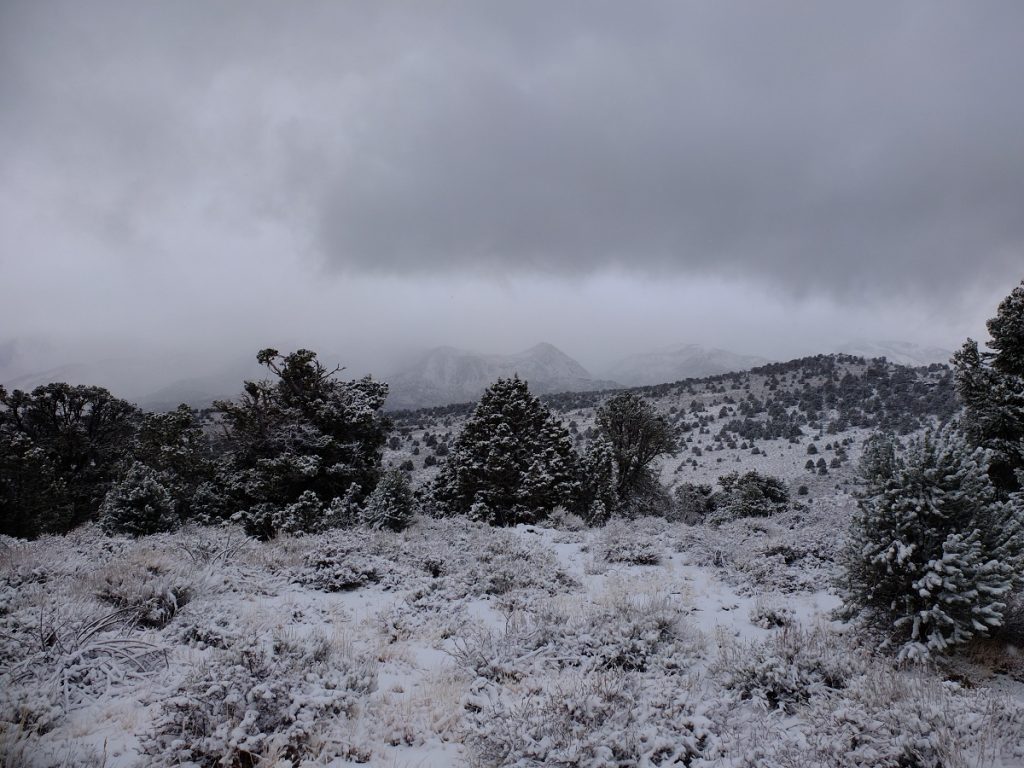
Pinyons do not technically seem to require stratification, but they do experience it naturally and I think it’s good for the seeds to experience a cold period before germinating. I’ve found that as soon as the soils remain consistently warm, the pinyon nuts will start sprouting. They should be planted straight into the ground in dry soils, but could also be grown in pots as long as the pots are deep enough. These trees will need A LOT of space for root depth…
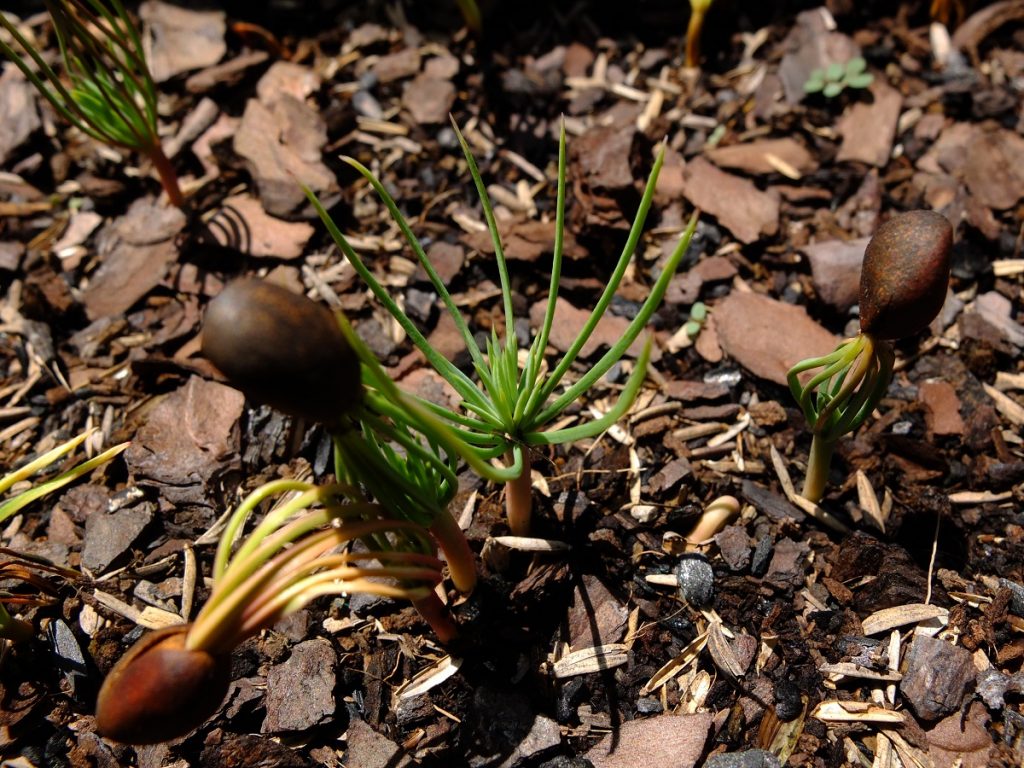
They don’t seem to take kindly at all to transplanting, but if you’re exceedingly careful, it is possible to have success.
They should be shielded from the full strength of the sun during their early years. Only established trees fare well in the full sun. These trees take a very long time to mature. They might not produce their first nuts for thirty years or more. And when they do, no tree will produce nuts every year. But viewed at the level of the whole forest, there will be production of pinenuts every year.
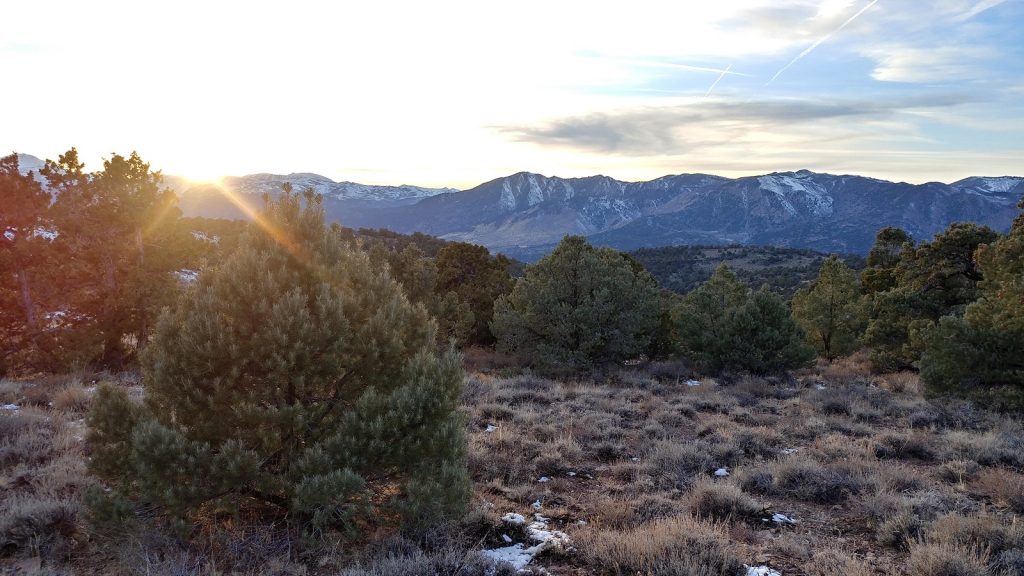
Pinyon jays are active spreaders of pinyon nuts and are responsible for the planting of thousands of acres of forest. Indigenous human beings may have also made intentional pinyon pine plantings in the past, but this is difficult to prove from a modern scientific point of view. Perhaps human influenced distribution patterns could be uncovered with phylogenetics, for example if high levels of polyphyly can be demonstrated in the Pinus section Cembroides, or specifically with the species Pinus monophylla, P. edulis, and their subspecies.
In addition to pinenuts, there was an abundance of jackrabbits as wild game to eat and other wild root foods such as onions, sego lilies (Calochortus sp.), yampah (Perideridia bolanderi), and some biscuitroots, as well as the medicinal biscuitroot toza’a (Lomatium dissectum). And up on some of the higher ridges, the tops of bitterroot (Lewisia nevadensis) were beginning to poke up even in early December.
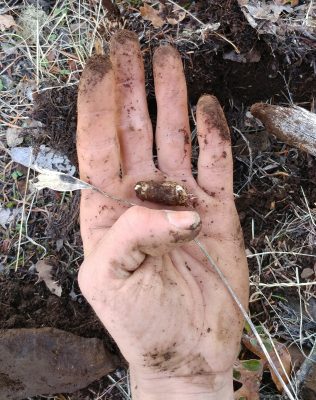
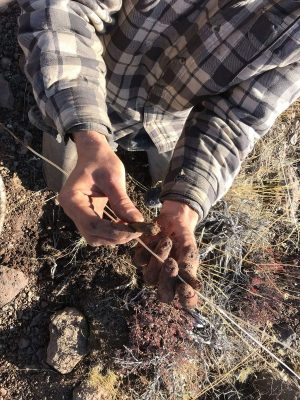
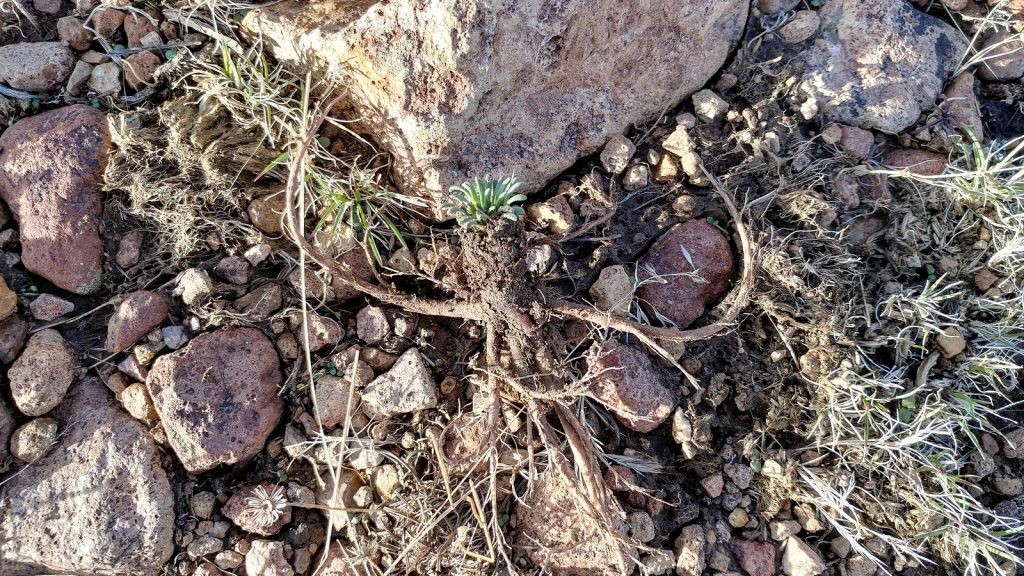
Today pinyon-juniper forests are threatened not only by forest fires, ranching, timbering, and mining, but also by mainstream conservation. Under the guise of protecting sage-grouse habitat, large swaths of pinyon-juniper forests are being uprooted by tractors and chains. It is a travesty of science, policy, and morality leading thoughtless ecological destruction. Mojave Desert Blog does a good job covering the issue. Will Falk’s blog also covers the issue.
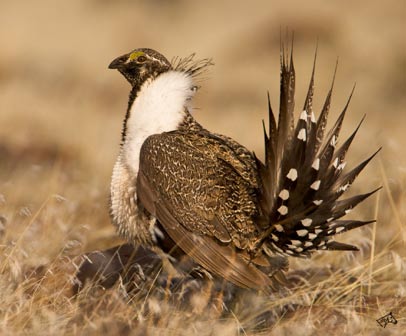
Crucially, one of the things pointed out by those destroying pinyon-juniper ecosystems is that these woodlands accumulate a lot of fuel load in the form of dead branches and twigs. Destroying the forests is thus seen as a “preventative measure” against fire. It is also thought that the pinyon-juniper forests must be modern encroachments, because fuel loads that high mean the forests would have historically burned away to nothing (fire is completely destructive to pinyon-juniper forest) several times over within the span of a century. But what gets overlooked in all this is the human relationship with the pinyon-juniper forests. When the pinyon forests are peopled every fall and winter, the people gather up the twigs and dead branches and limbs to keep their fires going. Human-pinyon interactions actually perform the service of lightening the fuel loads of the ecosystem.
Additionally, views of pinyon-juniper forest “invasion” often takes the short-sighted perspective of the last century. But we know from history that during the late 1800s and into the early twentieth century, we know that there was a gold rush, boomtown, logging, smelting of ore, and other mining operations which relied heavily on the supply of timber from the pinyon-juniper woodlands. As the cancer of extraction-based industry grew upon the land, the pinyon-juniper forests were reduced to nothing and dispossessed. Today, rather than “invading,” the trees are simply reclaiming lands they once possessed.
In a nutshell (ba-doom-psh!), removal of pinyon-juniper forest is a poorly-hidden ploy at the behest of cattle farmers to clear more space for ranching. Clearing pinyon-juniper forest does not magically create sage-grouse habitat, but it does destroy a functional ecosystem which could feed hundreds if not thousands of people.
Special thanks to Dr. Melvin Brewster and Joseph Lent with the Bridgeport Indian Colony for providing the Numu names of plants and sharing insights and experiences, and thank you also to Finisia Medrano for sharing some traditional ecological knowledge with me. Without cultural preservation of intricate plant knowledge, one could never figure this stuff out in an entire lifetime. Traditional Ecological Knowledge reveals many things that would seem counter-intuitive in another light. We’re all standing on the shoulders of giants here. And importantly, thank you to the indigenous elders and communities which kept these traditions alive for so many years and which continue to keep them alive.
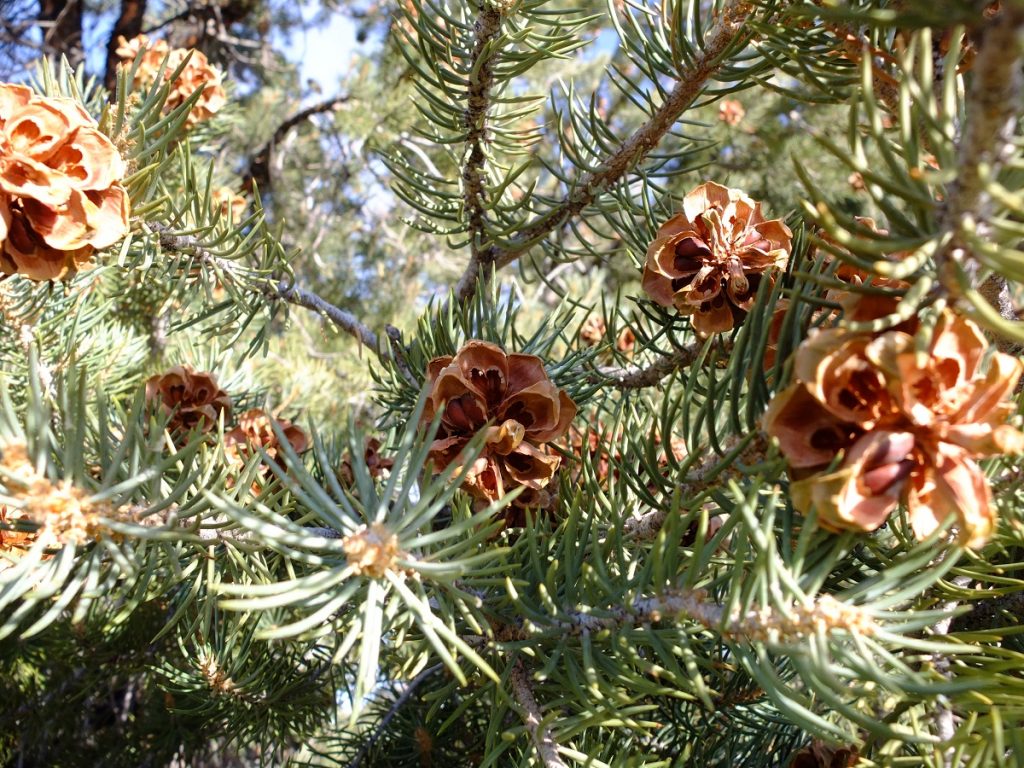
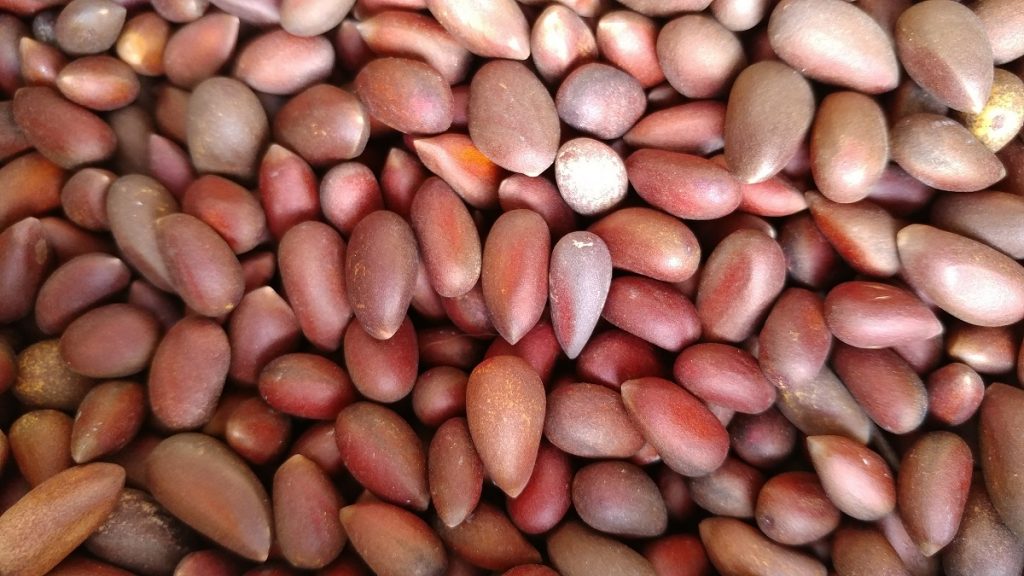
Excellent description- I love the inclusion of the native names for the plants, and I was inspired by the different ways that interactions with humans can be helpful to Tubape.
There are lots of pinyon pines where I live and am very grateful for this in-depth article. Thanks! : )
Thanks for the info. I will re read and make notes. The Pinyon/Junipers are my neighbors here in Taos.